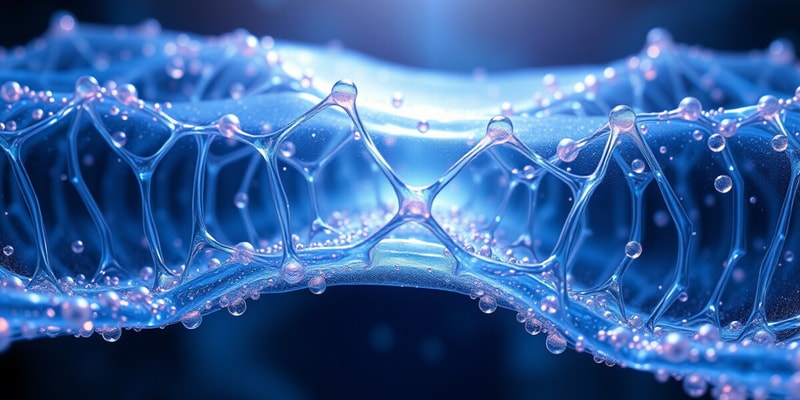Questions and Answers
What is the primary structural component of the cell membrane that forms a bilayer?
Which type of proteins span the entire cell membrane?
Which characteristic of the cell membrane allows it to selectively control the passage of substances?
What role do carbohydrates play in the cell membrane?
Signup and view all the answers
Which model best describes the structure of the cell membrane?
Signup and view all the answers
What happens when the cell membrane is damaged?
Signup and view all the answers
What is a consequence of disturbances in cell membrane function?
Signup and view all the answers
The membrane potential is important for which cellular function?
Signup and view all the answers
Study Notes
Zellmembran (Cell Membrane)
-
Definition:
- Eine semipermeable Schicht, die das Innere der Zelle vom Extrazellulärraum trennt.
-
Hauptbestandteile:
-
Phospholipide:
- Doppelschicht (Lipid-Doppelschicht) mit hydrophilen Köpfen und hydrophoben Schwänzen.
-
Proteine:
- Integrale Proteine (durchdringen die Membran) und periphere Proteine (sitzen an der Membranoberfläche).
-
Kohlenhydrate:
- Oft an Proteine (Glykoproteine) oder Lipide (Glykolipide) gebunden; wichtig für Zell-Zell-Erkennung.
-
Phospholipide:
-
Funktionen:
-
Barriere:
- Regelt den Stoffaustausch zwischen Innen- und Außenwelt.
-
Transport:
- Ermöglicht aktiven und passiven Transport von Molekülen (z.B. über Transportproteine).
-
Signalübertragung:
- Rezeptoren auf der Membran empfangen Signale von anderen Zellen.
-
Zell-Zell-Kommunikation:
- Interaktionen über Oberflächenmoleküle.
-
Barriere:
-
Modell:
-
Fluid-Mosaik-Modell:
- Membran ist fluid, Proteine sind in der Lipidschicht verteilt, was Flexibilität und Bewegung ermöglicht.
-
Fluid-Mosaik-Modell:
-
Wichtige Eigenschaften:
-
Semipermeabilität:
- Bestimmte Substanzen können frei passieren, andere nicht.
-
Selbstheilung:
- Membranen können sich bei Verletzungen regenerieren.
-
Semipermeabilität:
-
Krankheiten:
- Störungen der Zellmembranfunktion können zu Krankheiten führen, z.B. Diabetes, Krebs.
-
Zusätzliche Strukturen:
-
Membranpotential:
- Elektrische Differenz über die Membran, wichtig für Nervenimpulse.
-
Zellwand (bei Pflanzen):
- Umgibt die Zellmembran, bietet zusätzlichen Schutz und Struktur.
-
Membranpotential:
Cell Membrane
-
Definition:
- A semipermeable layer separating the cell's interior from the extracellular space.
-
Main Components:
-
Phospholipids:
- Comprise a lipid bilayer with hydrophilic heads and hydrophobic tails, crucial for membrane structure.
-
Proteins:
- Integral proteins penetrate the membrane, while peripheral proteins are located on the membrane's surface.
-
Carbohydrates:
- Often attached to proteins (glycoproteins) or lipids (glycolipids), vital for cell recognition and communication.
-
Phospholipids:
-
Functions:
-
Barrier:
- Regulates the exchange of substances between the cell's interior and the external environment.
-
Transport:
- Facilitates both active and passive transport of molecules through transport proteins.
-
Signal Transduction:
- Membrane receptors receive signals from other cells, initiating cellular responses.
-
Cell-Cell Communication:
- Interactions occur through surface molecules, aiding in tissue formation and function.
-
Barrier:
-
Model:
-
Fluid Mosaic Model:
- Proposes that the membrane is fluid, with proteins dispersed within the lipid bilayer, allowing flexibility and movement.
-
Fluid Mosaic Model:
-
Important Properties:
-
Semipermeability:
- Allows selective passage of specific substances while restricting others.
-
Self-Healing:
- Membranes can reform and heal after injuries, maintaining cellular integrity.
-
Semipermeability:
-
Diseases:
- Dysfunction in membrane functions can lead to diseases such as diabetes and cancer.
-
Additional Structures:
-
Membrane Potential:
- The electrical difference across the membrane is essential for transmitting nerve impulses.
-
Cell Wall (in Plants):
- Encloses the cell membrane, providing extra protection and structural support.
-
Membrane Potential:
Studying That Suits You
Use AI to generate personalized quizzes and flashcards to suit your learning preferences.
Description
Test your knowledge of the cell membrane's structure and function. This quiz covers the definition, main components like phospholipids, proteins, and carbohydrates, highlighting their roles in cellular processes. Perfect for biology students!




